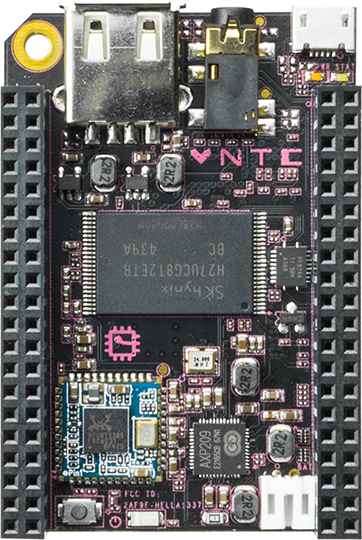C.H.I.P.

Overview
The NextThing Co’s C.H.I.P. uses an Allwinner R8 or G8 processor. The following functionality is supported:
- 3x I²C buses
- 1x SPI bus with 1x chip-enable
- 2x high performance edge detection enabled memory-mapped GPIO pins
- 41x high performance memory-mapped GPIO pins (the “LCD” and “CSI” pins and a few more)
- 8x low performance GPIO pins via pcf8574 I²C I/O extender (“XIO” pins)
Warning
Sadly NextThing Co shut down its activities. It had an awesome web flasher so it’s really too bad.
- Reddit /r/ChipCommunity is still active.
- GitHub:
- https://github.com/chip-community contains slightly more recent content.
- https://github.com/NextThingCo contains original content.
- https://gist.github.com/verticalgrain/deae2821213a891747e08e2d6492808a may be of help to try flashing.
- chip-community.org used to be volunteer based community but as of 2021 the server is offline.
Support
The NextThing Co’s C.H.I.P. board is supported using sysfs drivers as well as using high performance memory-mapped I/O for gpio pins.
periphwas tested with NTC provided 4.4.13+ kernel Debian.- C.H.I.P. is not officially supported anymore.
- C.H.I.P. Pro and PocketCHIP never had specific headers defined, just use the CPU gpio number instead.
Drivers
- CPU driver lives in periph.io/x/host/v3/allwinner.
- Headers driver lives in
periph.io/x/host/v3/chip. It
defines both
U13andU14with the aliases as printed on the actual headers. - sysfs driver lives in periph.io/x/host/v3/sysfs.
GPIO
Most GPIO are supported at extremely high speed via memory mapped GPIO registers.
Interrupt based GPIO edge detection is only supported on a few of the processor’s pins: AP-EINT1(PG1), AP-EINT3(PB3), CSIPCK(PE0), and CSICK(PE1).
Edge detection is also supported on the XIO pins, but this feature is rather limited due to the device and the driver (for example, the driver interrupts on all edges).
I²C
The recent images released by NTC have the I²C driver loaded by default and
exposes all three I²C buses but only 2 are usable. If running a stale image,
update with sudo apt update && sudo apt upgrade
- I²C #0: not available on the headers but has axp209 power control chip
- I²C #2: U13 pins 9 & 11
- I²C #2: U14 pins 25 & 26, has pcf8574 I/O extender
SPI
The SPI driver is included on recent images but a DTBO (Device Tree Binary
Overlay) is required in order to create the /dev/spi32766.0 device and connect
it to the pins.
- SPI2.0 or SPI32766.0: U14 pins 27, 28, 29, 30; only a single chip-select is supported
To enable, run the following:
mkdir -p /sys/kernel/config/device-tree/overlays/spi
cat /lib/firmware/nextthingco/chip/sample-spi.dtbo > /sys/kernel/config/device-tree/overlays/spi/dtbo
This needs to be done at each boot. A good location is to add the above into
/etc/rc.local before the exit 0 statement.
Buying
- The C.H.I.P. was directly distributed by NextThing Co but is not available anymore.
The periph authors do not endorse any specific seller. These are only provided for your convenience.
 Edit this page
Edit this page